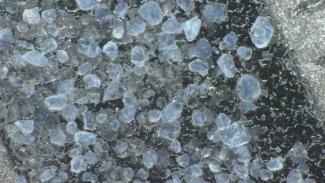NETL is dedicated to its mission to enhance the nation’s energy foundation and protect the environment for future generations. Our scientists and engineers work diligently to create technology solutions to our nation’s energy challenges and the advances they make in the Lab have far-reaching impacts. However, they reach their full potential after making the challenging leap from the laboratory to the marketplace where they benefit the greatest number of people as quickly and efficiently as possible.
With that goal in mind, NETL specialists work to open a wide array of pathways that take technologies to market. For example, patent licensing opportunities are key components of NETL’s technology transfer approach. As part of a federal agency, NETL grants licenses that permit private companies to further develop, use, make or sell a patent-pending or patented technology or process. NETL searches for licensing partners who can demonstrate a plan for technology development and marketing — key elements that help demonstrate a high probability for commercial success — and plans to make the benefits of the technology accessible to the public.
In 2018, we found two licensing partners involving the Lab’s Variable Grid Tool and its Basic Immobilized Amine/Silica Sorbent (BIAS) technology.
Commercializing Technology for Improved Spatial Data Analysis and Risk Assessment
In 2018, NETL granted a software license for its Variable Grid Method (VGM) Tool to aid in the analysis and interpretation of spatial data trends to a Texas-based startup called VariGrid Explorations LLC. NETL’s VGM is a novel approach to data visualization that employs geographic information system capabilities to simultaneously quantify and visualize spatial data trends and underlying data uncertainty. The method provides a user-friendly, flexible, and reliable tool to effectively communicate spatial data, as well as the data’s inherent uncertainties, in a single, unified product.
Applications that use big data, data analytics, and advanced computing run an inherent risk that results could be misleading or contain unseen error and uncertainty. The VGM is a simple, widely accepted tool for communicating that uncertainty or error with spatial data driven products. VGM helps communicate the relationship between uncertainty and spatial data to effectively guide research, support advanced computation analyses, and inform management and policy decisions. The method is applicable to a wide range of end users for reducing risks, improving decision-making, and reducing costs.
VariGrid Explorations intends to deploy the software system into targeted markets for specific geophysical applications. One application is oil and gas reservoir analysis, where the technology will allow petrophysicists and reservoir engineers to provide more realistic presentations of computed reservoir properties and oil in place. The ability to account for uncertainty will enable decisions to be made with greater accuracy.
Commercializing Technology for Removing Heavy Metals from Industrial and Municipal Water Supplies
A recent licensing agreement between NETL and PQ Corporation may lead to an effective, innovative approach to filtering industrial and municipal water. In 2018, NETL partnered with PQ Corporation — a leading, highly diversified global provider of specialty catalysts, specialty materials, chemicals, and services — in a partially exclusive license arrangement to commercialize NETL’s BIAS technology, a revolutionary new sorbent-based technology capable of recovering rare earth elements (REE) and removing hazardous heavy metal contaminates like lead from industrial and municipal water supplies.
NETL’s researchers originally developed the BIAS technology as an effective material for collecting molecules of carbon dioxide from fossil fuel burning power plants. Continued development showed the sorbents, which resemble microscopic pearls less than 800 micrometers in diameter, could be effective as a product that resists water, is regenerable, and can target heavy metals. The BIAS technology has shown potential application for water treatment and collecting valuable rare earth elements, which are vital to modern technologies.
PQ Corporation, which is based in Malvern, Pennsylvania, has a long history of working with municipal water treatment facilities, oil and gas drilling industries, and producers of precious metals, making the company an excellent partner for commercializing the BIAS technology. The commercialization partnership with PQ Corporation could lead to a new product that can provide the first cost-effective method for removing REEs and lead from water with minimal to no impact to the environment.
In the 1940s, Vannevar Bush, the nation’s very first national science advisor and prolific scientific innovator wrote that “New products, new industries, and more jobs require continuous additions of knowledge to the laws of nature, and the application of that knowledge to practical purposes.”




